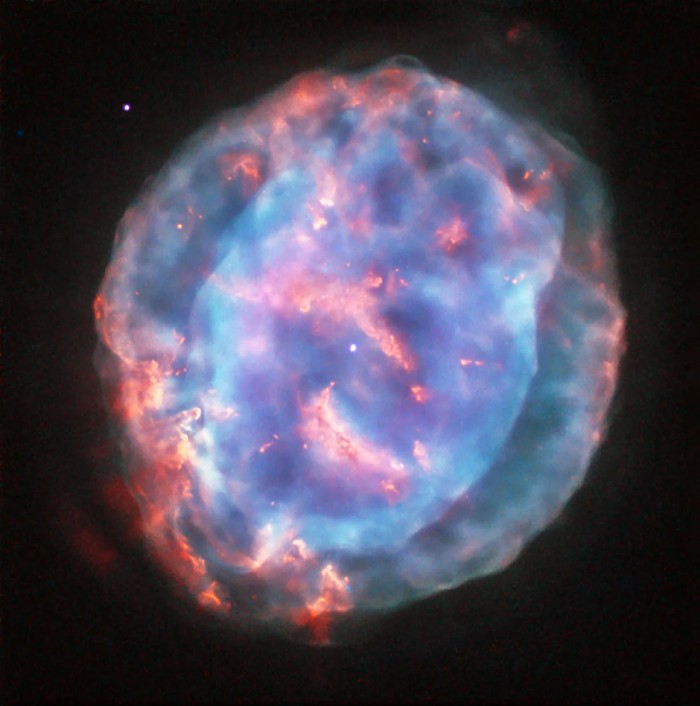NGC 6818, also known as the Little Gem Nebula or Caldwell 57, is a planetary nebula located in the constellation Sagittarius, approximately 6,000 light-years from Earth. It was discovered by the British astronomer Sir John Herschel in 1836 during his survey of the southern skies. The nebula earned its popular nickname, “Little Gem,” due to its compact size and vibrant colours when viewed through a telescope, resembling a gem-like appearance in the night sky.
Physical Characteristics
NGC 6818 is a typical planetary nebula, which forms when a dying star expels its outer layers, leaving behind an expanding shell of ionized gas. This ejected material glows due to the intense ultraviolet radiation emitted by the remaining stellar core, now a hot white dwarf. The central star of NGC 6818 is responsible for energizing the surrounding gas, causing it to emit the colourful light seen by observers.
The nebula spans about 0.4 arcminutes in diameter, translating to a physical size of approximately 0.3 light-years. Its structure is particularly notable for its bright central region, which is slightly irregular in shape, contrasted with the surrounding fainter, more diffuse outer layers. The outer envelope shows evidence of more complex processes such as bipolar outflows, giving the nebula a layered, multi-shell appearance when viewed in detail.
Composition
The spectral signature of NGC 6818 reveals the presence of several ionized elements. The most prominent emission lines are those of hydrogen (H-alpha) and doubly ionized oxygen (O III), which account for much of the nebula’s visual glow. The O III emissions are particularly responsible for the nebula’s characteristic blue-green hue, often seen in images and through telescopes. Other elements present in the nebula include nitrogen and helium, each contributing to the nebula’s complex color spectrum, depending on the level of ionization caused by the central star.
Evolutionary Stage
NGC 6818 represents the late stages of stellar evolution for a low to intermediate mass star, much like our Sun. After burning through its nuclear fuel, the star shed its outer layers via stellar winds, leaving its hot core exposed. This core is now a white dwarf, which will slowly cool over billions of years. Over time, the nebula will continue to expand and eventually dissipate into the surrounding interstellar medium. The process of forming planetary nebulae is crucial for recycling material, enriching the galaxy with heavier elements that were produced during the star’s lifetime.
Observation
The Little Gem Nebula is a popular target for amateur astronomers due to its brightness and small, but easily identifiable shape. Even with modest telescopes, it appears as a small but distinct object in the rich star fields of Sagittarius. Larger telescopes can reveal its more detailed structure, including its internal brightness variations and the faint outer halo that surrounds the central nebula. The nebula’s colours, ranging from the blue-green of oxygen to the red hues from hydrogen emissions, are visually striking, especially when viewed with higher magnifications.
NGC 6818 is relatively easy to locate in the night sky due to its position in Sagittarius, a constellation well known for its dense star fields and deep-sky objects near the galactic centre. The best time to observe NGC 6818 is during late spring to early autumn in the Northern Hemisphere, or late autumn to early spring in the Southern Hemisphere (around May to September). During these months, Sagittarius is high in the sky, providing optimal viewing conditions. Under dark skies, NGC 6818 stands out as a colourful, gem-like nebula, making it a rewarding object for both beginners and experienced observers alike.




